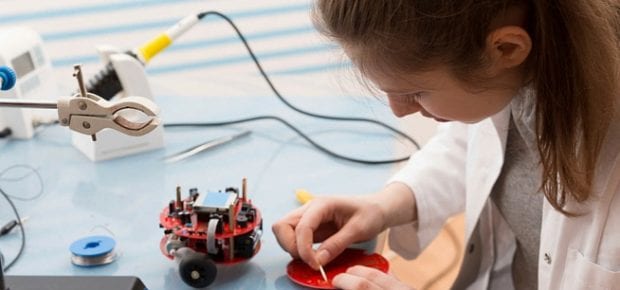May 23, 2016
By: Karen Bartleson, IEEE President-elect
I love my chosen profession – I love being an electronic engineer. But I must admit that for many years my focus has been almost exclusively trained on being the best engineer I could be and less so on the particulars of being a “woman engineer.”
On 23 May, I will have the pleasure of participating in the IEEE Women in Engineering’s (WIE) International Leadership Conference in San Jose, California. It’s another activity that has given me cause to devote a great deal of thought to “women in engineering.” I’ve taken time to consider the uniqueness of women’s experience in technology and engineering; I’ve considered the importance of having more women in our chosen fields; and I’ve considered what engineers can do – male and female – to make that happen. I urge you to do the same.
It wasn’t until my sophomore year at Cal Poly, after encountering some members of the local chapter of The Society of Women Engineers that I gave any serious consideration to a becoming an engineer. Actually, until then I didn’t even know there was such a field as engineering. My mother was a scientist and my father was an English professor in the U.S. Air Force, and I had never been exposed to engineering. But the more I learned about it, the more it appealed to me. I very much enjoyed and seemed to have a knack for math and science. The notion of applying science and logic to solve problems for people inspired me. The opportunity to make a living while making a positive difference in the world sealed it for me.
So I decided to take the leap, and later that year declared myself an “Engineering Major.” The fact that I was a “woman engineering major,” didn’t really occur to me. I didn’t set out to prove anything or to be an activist or iconoclast. The fact that my chosen career path ran straight into male-dominated terrain was an after-thought because I didn’t realize that engineering was typically a “man’s field”. But once the engineering classes began, and I found myself to be, more often than not, the only female in the room, that fact became starkly apparent.
Yet for the remainder of my undergraduate and post-graduate studies, and through much of my professional career, I never dwelled on it much. I was comfortable collaborating and working with men. As long as the playing field was level; and I had an opportunity to show what I could do; the rest would take care of itself, I assumed. But in retrospect, that approach was probably a little bit of wishful thinking and perhaps even a little naïve.
Thankfully, our profession and our society have evolved considerably since I first started out. Together with most professional women of my generation, I was subjected to the subtle and not-so-subtle condescension; the inappropriate remarks; the soft exclusion; the double-standards. Fortunately, these incidences were few and far between. A while ago, I experienced what it’s like to discover (by chance) that male colleagues – supposedly my equals and peers – were being paid substantially more than I for the same job responsibilities. I also got to experience what it’s like to be passed over for a promotion in favor of a less qualified male. Shortly thereafter, I informed my employers that I did in fact get and accept a promotion – at another company. Thankfully, the overwhelming majority of my male colleagues today wouldn’t tolerate, let alone participate in that kind of behavior or discrimination, but I haven’t much doubt that it is still goes on.
As President-elect of IEEE, I have made interacting with and supporting our Young Professionals a primary priority. And I am very pleased to see how diversity and inclusion is second-nature to our professions’ next generation. But even in our more enlightened society, women in engineering and other STEM fields are still underrepresented. We still face unique professional challenges — not the least of which involve reconciling parenthood and career — and a playing field that is not yet entirely level. These issues must be discussed and they must be resolved – not for women’s sake, but for engineering’s sake and by extension, for the sake of humankind.
The global population is expected to gain another two billion people by the middle of this century. Technology has some work to do if we are to sustainably feed, hydrate, power, move, house, and see to the health of 9-10 billion people from the same finite supply of natural resources. With so much at stake, can we really afford to squander the talents and abilities of half the population? Of course we can’t.
Yet, according to some studies, the density of women in STEM careers over the past 30 years has actually decreased. The precise nature of the problem varies by geography and culture, but the trend is a downward one. According to the National Science Foundation, women represent just 13% of engineers and little more than 8% of electrical and electronic engineers in the U.S. I certainly don’t believe this is because girls are not as capable as boys in learning STEM!
In the Middle East (UAE to be exact) the numbers of men and women studying engineering is more evenly balanced. But as colleagues have related to me, most often women engineering graduates elect to forgo a career and dedicate themselves to being a wife and mother. In Eastern Europe, specifically Armenia, the company I worked for would hire substantial numbers of engineering interns, at least half of which – possibly more – were female. Not surprisingly, the number of women engineers at that company seemed to be more on par with that of men. Globally, the general accepted participation rate of women in STEM careers sits somewhere around 30 percent.
The low numbers of women in engineering and technology is a complex challenge. I don’t pretend to have all the answers. But one thing is for certain – this challenge and these questions highlight why IEEE Women in Engineering is such a worthwhile and necessary organization. We engineers – irrespective of gender – must ask, explore and debate these questions. Toward that end, I am very much looking forward to this month’s WIE International Leadership Conference. I am eager to discuss these important issues with my IEEE colleagues from around the world, and hopefully, to get closer to the eventual solutions.






 Meaningful Momentum or Running in Place?
Meaningful Momentum or Running in Place? AI Through Our Ages
AI Through Our Ages Liquid Infrastructure: Our Planet's Most Precious Resource
Liquid Infrastructure: Our Planet's Most Precious Resource The Impact of Technology in 2025
The Impact of Technology in 2025 Quantum and AI: Safeguards or Threats to Cybersecurity?
Quantum and AI: Safeguards or Threats to Cybersecurity? Why AI Can't Live Without Us
Why AI Can't Live Without Us Bits, Bytes, Buildings and Bridges: Digital-Driven Infrastructure
Bits, Bytes, Buildings and Bridges: Digital-Driven Infrastructure Impact of Technology in 2024
Impact of Technology in 2024 Emerging AI Cybersecurity Challenges and Solutions
Emerging AI Cybersecurity Challenges and Solutions The Skies are Unlimited
The Skies are Unlimited Smart Cities 2030: How Tech is Reshaping Urbanscapes
Smart Cities 2030: How Tech is Reshaping Urbanscapes Impact of Technology 2023
Impact of Technology 2023 Cybersecurity for Life-Changing Innovations
Cybersecurity for Life-Changing Innovations Smarter Wearables Healthier Life
Smarter Wearables Healthier Life Infrastructure In Motion
Infrastructure In Motion The Impact of Tech in 2022 and Beyond
The Impact of Tech in 2022 and Beyond Cybersecurity, Technology and Protecting Our World
Cybersecurity, Technology and Protecting Our World How Technology Helps us Understand Our Health and Wellness
How Technology Helps us Understand Our Health and Wellness The Resilience of Humanity
The Resilience of Humanity Harnessing and Sustaining our Natural Resources
Harnessing and Sustaining our Natural Resources Creating Healthy Spaces Through Technology
Creating Healthy Spaces Through Technology Exceptional Infrastructure Challenges, Technology and Humanity
Exceptional Infrastructure Challenges, Technology and Humanity The Global Impact of IEEE's 802 Standards
The Global Impact of IEEE's 802 Standards Scenes of our Cyber Lives: The Security Threats and Technology Solutions Protecting Us
Scenes of our Cyber Lives: The Security Threats and Technology Solutions Protecting Us How Millennial Parents are Embracing Health and Wellness Technologies for Their Generation Alpha Kids
How Millennial Parents are Embracing Health and Wellness Technologies for Their Generation Alpha Kids Space Exploration, Technology and Our Lives
Space Exploration, Technology and Our Lives Global Innovation and the Environment
Global Innovation and the Environment How Technology, Privacy and Security are Changing Each Other (And Us)
How Technology, Privacy and Security are Changing Each Other (And Us) Find us in booth 31506, LVCC South Hall 3 and experience the Technology Moon Walk
Find us in booth 31506, LVCC South Hall 3 and experience the Technology Moon Walk Virtual and Mixed Reality
Virtual and Mixed Reality How Robots are Improving our Health
How Robots are Improving our Health IEEE Experts and the Robots They are Teaching
IEEE Experts and the Robots They are Teaching See how millennial parents around the world see AI impacting the lives of their tech-infused offspring
See how millennial parents around the world see AI impacting the lives of their tech-infused offspring Take the journey from farm to table and learn how IoT will help us reach the rising demand for food production
Take the journey from farm to table and learn how IoT will help us reach the rising demand for food production Watch technical experts discuss the latest cyber threats
Watch technical experts discuss the latest cyber threats Explore how researchers, teachers, explorers, healthcare and medical professionals use immersive technologies
Explore how researchers, teachers, explorers, healthcare and medical professionals use immersive technologies Follow the timeline to see how Generation AI will be impacted by technology
Follow the timeline to see how Generation AI will be impacted by technology Learn how your IoT data can be used by experiencing a day in a connected life
Learn how your IoT data can be used by experiencing a day in a connected life Listen to technical experts discuss the biggest security threats today
Listen to technical experts discuss the biggest security threats today See how tech has influenced and evolved with the Games
See how tech has influenced and evolved with the Games Enter our virtual home to explore the IoT (Internet of Things) technologies
Enter our virtual home to explore the IoT (Internet of Things) technologies Explore an interactive map showcasing exciting innovations in robotics
Explore an interactive map showcasing exciting innovations in robotics Interactively explore A.I. in recent Hollywood movies
Interactively explore A.I. in recent Hollywood movies Get immersed in technologies that will improve patients' lives
Get immersed in technologies that will improve patients' lives